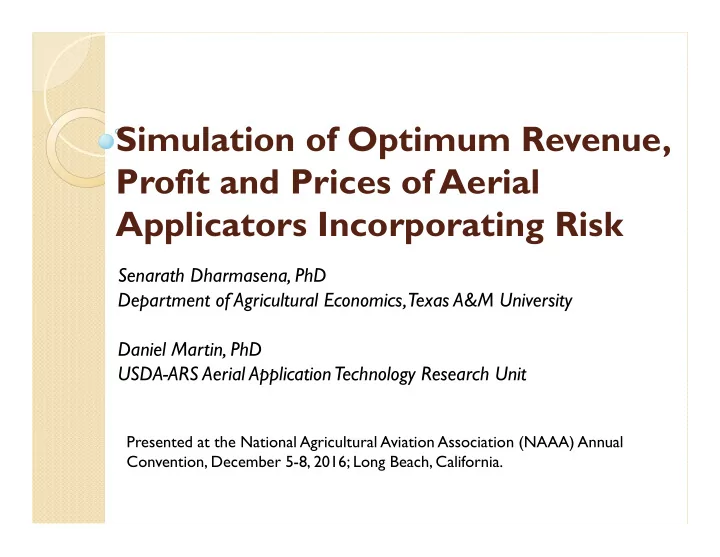

Simulation of Optimum Revenue, Profit and Prices of Aerial Applicators Incorporating Risk Senarath Dharmasena, PhD Department of Agricultural Economics, Texas A&M University Daniel Martin, PhD USDA-ARS Aerial Application Technology Research Unit Presented at the National Agricultural Aviation Association (NAAA) Annual Convention, December 5-8, 2016; Long Beach, California.
Motivation Aerial applicators face increasing competition from various aerial operators for spray jobs Small differences in the price charged per acre could make or break a business
Questions for thought? What is the best price to charge? What is the desired profit margin for a spray job and business? Would there be range of prices you can work with for a spray job? Is your current profit margin enough ◦ T o cover the next big purchase? ◦ T o overcome unforeseen contingencies?
Questions for thought? What is your aircraft operating cost per hour, and how does that factor into the equation? Does your current profit margin cover all or most of your expenses? Does the price per acre really represent the price per job?
Revenue Pretty simple Revenue ◦ Price per job (in terms of aircraft time) ◦ Price per acre (this is what farmer/client wants) ◦ Area (in acres)
Cost Fixed expenses ◦ Aircraft ◦ Facilities (hanger, runway) ◦ Other equipment (loader trucks, application equipment— booms and nozzles, guidance system) ◦ Insurance Variable expenses ◦ fuel ◦ Aircraft repair and maintenance ◦ Runway repair and maintenance ◦ Labor (workman’s comp, pilot, mixer/loader and scheduler) ◦ Taxes ◦ Costs associated with distance to travel to the filed from hanger
Risks Risks associated with operation ◦ Obstacles (cell tower, wind turbines, trees, power lines, center pivots) ◦ Sensitive crops (organic farms, non-round up ready crops, home gardens) ◦ Elementary schools, hospitals ◦ Aircraft turnaround times ◦ Unanticipated mechanical expenses
100 Acres Application time: 21.295 minutes Distance to field: 5 miles 100 Acres Scenario 1 Application time: 28.225 minutes Distance to field: 5 miles 100 Acres Application time: 23.085 minutes Distance to field: 5 miles
Scenario 1: Charge same price Aircraft operating cost $940.83 $769.50 $709.83 Labor cost Pilot $200.00 $200.00 $200.00 Mixer/Loader $5.65 $4.62 $4.26 Total cost $1,146.48 $974.12 $914.09 Price per acre $10.00 $10.00 $10.00 Gross revenue $1,000.00 $1,000.00 $1,000.00 Net revenue -$146.48 $25.88 $85.91 Profit margin -14.65% 2.59% 8.59%
Scenario 1: Charge different prices Aircraft operating cost $940.83 $769.50 $709.83 Labor cost Pilot $315.60 $258.00 $238.00 Mixer/Loader $5.65 $4.62 $4.26 Total Cost $1,262.08 $1,032.12 $952.09 Price per acre $15.78 $12.90 $11.90 Gross revenue $1,578.00 $1,290.00 $1,190.00 Net revenue $315.92 $257.88 $237.91 profit margin 20% 20% 20%
100 Acres 100 Acres Application time: Application time: 25.58 minutes 21.295 minutes Distance to field: 10 Distance to field: 5 miles miles Price: $10/acre Price: $10/acre Profit margin: -5.78% Profit margin: 8.59% Scenario 2 100 Acres 100 Acres Application time: Application time: 32.51 28.225 minutes minutes Distance to field: 5 Distance to field: 10 miles miles Price $10/acre Price $10/acre Profit margin: Profit margin: -14.65% -29.02%
100 Acres Application time: 25.58 minutes Distance to field: 10 miles Price: $14.30/acre Profit margin: 20% Scenario 2 100 Acres Application time: 28.225 minutes Distance to field: 5 miles Price $15.75/acre Profit margin: 20%
Scenario 3 Price: ?? Risks Price: ?? Price: ?? Price: ??
What next? Transformational outcome of the work ◦ T ool that can incorporate all scenarios that allows you to gain a profit to stay in the business ◦ Develop an application (app) to predict price for different jobs to stay in the business Encourage to start keeping good records, especially cost side to plug into the model to run scenarios for your operation
Questions, Comments… Sam Dharmasena, PhD sdharmasena@tamu.edu (979)446-1449; (979)862-2894 Department of Agricultural Economics, Texas A&M University Daniel Martin, PhD Dan.martin@ars.usda.gov (979)229-6055 USDA-ARS Aerial Application Technology Research Unit
Recommend
More recommend